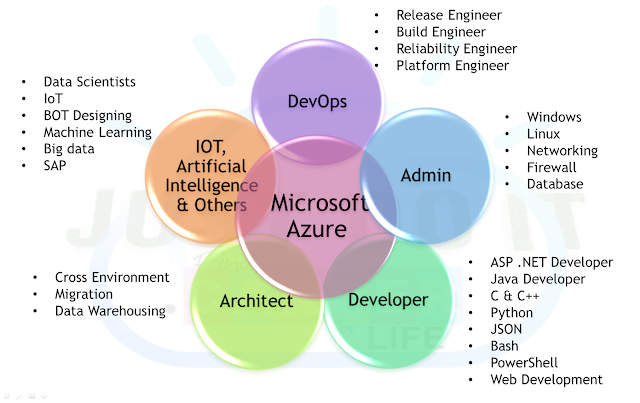6. Microsoft Azure for Beginners | Azure Storage Account | Azure Blob | File Share | Tables | Queues
Azure Storage Account
A Storage Account in Azure is a logical
(Virtual) division of the storage hardware at Azure Datacenters, where we are
provided with the explicit access to that particular account and storage via
different medium such as (Azure Portal or Storage Explorer or any other tool)
to store our data which are secured with different layers of security.
Microsoft
allow to create a storage account at the subscription level in a resource
group. Later we can link this storage account with a Virtual Network and its
subnet if we want it to be used by internal users only.
Further,
under storage account we can use different types of storages as per our need.
There are four type of storage under each storage account:
* Blob Storage
* File Storage / File Share
* Table Storage
* Queue Storage
Blob Storage
Blob is a type of storage where you can upload any
type of file or folder with any extension. There are multiple ways to access
blob storage but the most popular are – either to access the blob storage using
Azure Portal or ‘Azure Storage Explorer’.
Azure Storage Explorer: It is a Microsoft tool which is
specially developed to access different storage account in Azure from your
local machine or as per need. To download this tool just go to google and type
–‘Azure Storage Explorer download’ you will get the first link to the page to
download the tool.
The objects
created / uploaded in the blob storage could be used to upload or load in
different resources in Azure or even to your web based solution. Each object is
associated with a link (URL), which can be seen in properties of that object.
Capacity of Blob storage is Up to 2 PiB Account and object size limit is up to
about 4.75 TiB per block blob. It’s costing is based on bytes written in the
Blob. Disks are also type of blob storage and its maximum allowed size is 4 TiB
disk.
File Storage
File
Storage is specifically used as to provide the cloud based storage solution to
your environment shared objects or files. This storage type works as a Network
drive in your machine and could be attached by using a Power-shell script
provided once the file share is created in storage account (Click on Connect
option in your File to get the PS script to connect locally).
**
Conditional Access: You will be able to configure this shared Network Drive to
your local machine, only if Port # 445
is open to your network and machine. File share communicates with your
local machine as a Network drive using this port.
If you are
looking to set up a network drive for a specific team in your organization and
you want your team to drop the shared files and object at one place and can get
easy access to it whenever needed, this could be best solution for you on
Azure. Capacity of a File Share is 5 TiB file shares and object size up to 1
TiB per file. It’s costing is based on file size.
Table Storage
Relational
data like Tables could be uploaded in Table Storage type in Azure. This table is
callable or can be linked or uploaded to database in your Azure environment when
so ever needed.
You can
create a table in Azure portal but to add new column or to upload content that
is do-able by using Azure Storage Explorer on your local machine. You can
upload the Excel or CSV files by using the same tool in your local machine.
Currently,
till April 2019, maximum size of a File Storage that can be created is 5 TB. I
have specified the date because Microsoft continuously upgrades their services
so later it may increase.
Queue Storage
Azure Queue
storage is a service for storing large numbers of messages that can be accessed
from anywhere in the world via authenticated calls using HTTP or HTTPS. A
single queue message can be up to 64 KB in size, and a queue can contain
millions of messages, up to the total capacity limit of a storage account.
Common uses
of Queue storage include:
* Creating a backlog of work to process asynchronously.
* Passing messages from an Azure web role to an Azure worker role.
* Creating a backlog of work to process asynchronously.
* Passing messages from an Azure web role to an Azure worker role.
Replication Strategy for Azure Storage Account:
* Locally-redundant storage (LRS): This is a simple, low-cost replication strategy. Data
is replicated synchronously 3 times within the primary region i.e within the
same datacenter locally.
* Geo-redundant storage (GRS): It is a cross-regional replication to protect against
regional outages. Data is replicated synchronously three times in the primary
region, and then replicated asynchronously to the secondary region.
*
Read Access
Geo-redundant storage (GRS): Read-access
geo-redundant storage (RA-GRS) maximizes availability for your storage account.
RA-GRS provides read-only access to the data in the secondary location, in
addition to geo-replication across two regions.

Nice post...
ReplyDeleteAzure cloud services